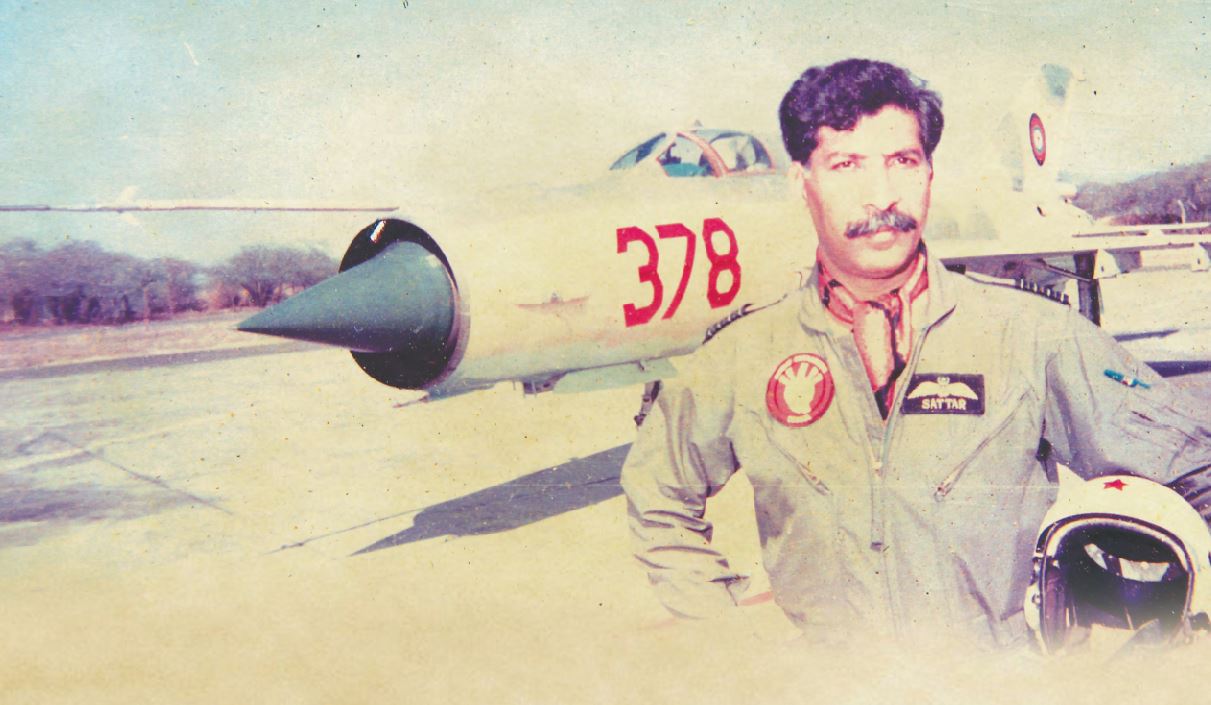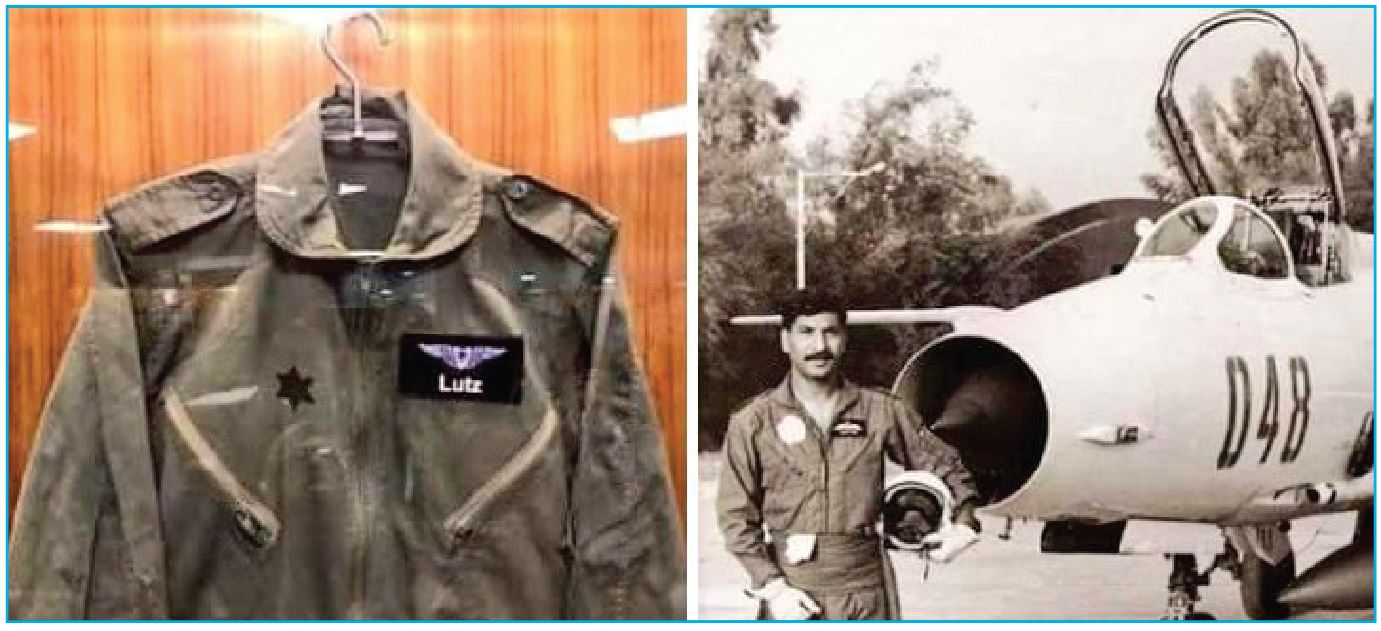Signalian
PDF THINK TANK: CONSULTANT

- Joined
- Aug 18, 2015
- Messages
- 10,608
- Reaction score
- 305
- Country
- Location
From Dumayr Air Base to Glory: The Tale of Shooting Down an Israeli Mirage
In the midst of the Arab-Israel War of 1973, Pakistan Air Force pilots flew with bravery and glory. The thirty second air combat of Flight Lieutenant Sattar Alvi showcased the bravery and skill of Pakistani pilots in defending the Syrian airspace. The adversary Mirage was instantly reduced to a smoldering wreck. The missile had hit its target with deadly accuracy, causing a deafening explosion that tore through the sky.

The month of April holds a special place in military aviation history as on April 26, 1973, a Pakistan Air Force (PAF) braveheart, Flight Lieutenant Sattar Alvi, etched his name in golden words by shooting down an Israeli Mirage aircraft while piloting a Syrian Air Force MiG-21 fighter jet. The aerial combat that occurred that day over Golan Heights is not just a story of a dogfight between two adversary aircraft, but a tale of valor, strategy, and ultimate triumph. It is a story that echoes through the corridors of time, a saga of unparalleled professionalism. In this air battle, the brave PAF pilots, armed with courage and skill, faced off against the technologically advanced Israeli Mirage fighter jets piloted by some of the world's most well-trained pilots. It is a reminder that no matter how insurmountable the odds may seem, there is always a way to triumph. It is a tale of courage, skill, and above all, the unyielding spirit of brotherhood.
The Arab-Israel War of 1973, also known as the Ramadan War, was one of the most intense conflicts the world had ever witnessed. It was a battle for survival, as the Arab nations fought to defend their sovereignty against Israeli aggression. PAF played a crucial role in this war, with its pilots and air defense controllers exhibiting unparalleled professionalism and bravery. As the war broke out, 16 PAF fighter pilots volunteered to support their Arab brethren and flew to the Middle East. The volunteers were divided into two groups, wherein half of them were deployed in Egypt.
The aerial combat that occurred that day over Golan Heights is not just a story of a dogfight between two adversary aircraft, but a tale of valor, strategy, and ultimate triumph. It is a story that echoes through the corridors of time, a saga of unparalleled professionalism.
In contrast, the remaining eight bravehearts were positioned at No. 67A Squadron (a detachment comprising all PAF pilots) of Dumayr Air Base, Syria. By the time the PAF batch reached Cairo, Egypt had agreed to a ceasefire and it was, therefore, decided that the PAF aircrew would continue to serve as instructors imparting flying training to their war-struck Egyptian brothers. However, the situation in Syria was a totally different story. Syria had not agreed to a ceasefire since Israeli operations in Golan were continuing at a threatening pace. Israeli Air Force missions included interdiction under the top cover well supported by intense radio and radar jamming. So just after arrival in Syria, the hasty checkouts by PAF aircrew were immediately followed by the serious business of Air Defence Alert scrambles and Combat Air Patrols from Dumayr Air Base.
The PAF formation using the call-sign “Shahbaz," though formidable in size, soon came to stand out owing to their innovative and bold tactics. The PAF aircrews were not just skilled aviators; their hearts were filled with love for their Arab brethren as they put their lives on the line everyday, determined to protect their allies. They flew sorties day and night, strafing Israeli positions and providing cover to the ground troops. The pilots flew their planes with precision, dodging enemy fire and taking out targets with deadly accuracy.
Despite the chaos and danger of war, the PAF contingent of eight valiant sons of the soil remained determined, so when the air defense alert hooter blew around 3:30 pm, Flight Lieutenant Sattar Alvi, along with his seven fellow PAF pilots, scrambled to face the threat of 56 intruding enemy aircraft.
On the eventful day of April 26, 1974, the aerial encounter saw Flight Lieutenant Sattar Alvi flying a Mig-21 fighter jet with Serial No. 1863, engaged in a deadly aerial battle with

Against the other, he did a steep reversal dropping his speed literally to zero. Flight Lieutenant Sattar Alvi proved to be more skilled in slow-speed combat than his opponent, who made the mistake of engaging him in a fight at a disadvantage. The tension was palpable as the two planes engaged in a deadly dance in the skies. The PAF pilot was determined to protect the brotherly Muslim country's sovereignty and was not willing to back down. The result was that within a few seconds, the second Mirage filled his gun sight. While Flight Lieutenant Sattar was worried about having to concentrate for precious seconds on aiming and shooting, the lead Mirage started to turn around to get him.
Thinking that help was at hand, the target Mirage decided to accelerate away. The quick-witted Sattar reckoned that a missile shot would be just right for the range his target had opened up to, and in just thirty seconds, Flight Lieutenant Sattar Alvi emerged victorious, shooting down the Israeli Mirage with a well-timed missile. The adversary Mirage was instantly reduced to a smoldering wreck. The missile had hit its target with deadly accuracy, causing a deafening explosion that tore through the sky. The pilot of the Israeli Mirage, Captain Lutz of No. 5 Air Wing based at Hatzor, was forced to eject from his disintegrated aircraft. Captain Lutz later succumbed to the wounds that he sustained during ejection.
It was later learned that the Israeli Mirages were on a reconnaissance mission, escorted by Phantoms of No. 1 Air Wing operating out of Ramat David Air Base. The Phantoms were to trap any interceptors while the Mirages carried out the recce. Timely warning by the radar controller (also from PAF) had turned the tables on the escorts, allowing Flight Lieutenant Sattar to shoot down one of the intruding Mirages while the remaining Israeli aircraft fled from the battle zone recognizing the superiority of the Pakistani pilots in air combat.

The encounter was an accolade for the courage and skill of Pakistani pilots, who were able to overcome the odds and emerge victorious against a formidable enemy. Flight Lieutenant Sattar Alvi's accurate missile hit was a shining example of the bravery and determination that it takes to defend one's ally against all threats. The emotional impact of the mission was felt not just in Pakistan and Syria, but around the world. It was a stark reminder that courage and determination can overcome even the most daunting challenges. It was later learned that the Israeli Mirages were on a reconnaissance mission, escorted by Phantoms of No. 1 Air Wing operating out of Ramat David Air Base. The Phantoms were to trap any interceptors while the Mirages carried out the recce. Timely warning by the radar controller (also from PAF) had turned the tables on the escorts, allowing Flight Lieutenant Sattar to shoot down one of the intruding Mirages while the remaining Israeli aircraft fled from the battle zone recognizing the superiority of the Pakistani pilots in air combat. Flight Lieutenant Sattar Alvi and his leader, Squadron Leader Arif Manzoor were awarded two of Syria’s highest decorations for gallantry, the Wisaam Faris and Wisaam Shuja’at, while the Government of Pakistan, in recognition of their valor, awarded them Sitara-e-Jurat.
The PAF pilots knew the stakes were high, yet they were willing to sacrifice, to do or die. With precision and skill, they took to the air, their planes roaring as they strafed enemy positions. Dodging and weaving, they took out targets with deadly accuracy, their professionalism shining through each and every action.

The thirty second air combat of Flight Lieutnant Sattar Alvi showcased the bravery and skill of Pakistani pilots in defending the Syrian airspace. In the midst of the Arab-Israel War of 1973, the Pakistan Air Force pilots flew with bravery and glory. Their planes soared through the skies, their hearts filled with determination and pride. Their mission was clear, to defend their Arab brothers against the Israeli aggression. The PAF pilots knew the stakes were high, yet they were willing to sacrifice, to do or die. With precision and skill, they took to the air, their planes roaring as they strafed enemy positions. Dodging and weaving, they took out targets with deadly accuracy, their professionalism shining through each and every action. They faced the toughest of challenges against the might of the Israeli Air Force's advanced technologies, but were undaunted; their loyalty to their Arab allies was unwavering, and their courage and determination an inspiration worth beholding. In fierce dogfights, they engaged the enemy with ferocity, taking out Israeli warplanes and forcing them to retreat without losing a single aircraft of their own. Their Arab allies hailed them as heroes, their actions inspiring a new generation of young pilots, enthralled by their professionalism and dedication.
The battle highlighted the importance of having a well-trained and equipped air force to deter potential aggressors. The event underlined the importance of quick reflexes, strategic thinking, and aircraft mastery in air combat, whereas the outcome of the air battle demonstrated the courage and determination of Pakistani pilots in protecting the sovereignty of a brotherly nation and ensuring the safety and security of its citizens. It was truly a moment of pride for the Pakistani nation and a source of inspiration for generations to come.
Group Captain Muhammad Bahroni is working as Director Public Relations at Directorate General Public Relations Air Force.
E-mail: bahroni_riyadi@yahoo.com

From Dumayr Air Base to Glory: The Tale of Shooting Down an Israeli Mirage
In the midst of the Arab-Israel War of 1973, Pakistan Air Force pilots flew with bravery and glory. The thirty second air combat of Flight Lieutenant Sattar Alvi showcased the bravery and skill of Pakistani pilots in defending the Syrian airspace. The adversary Mirage was instantly reduced to a...

